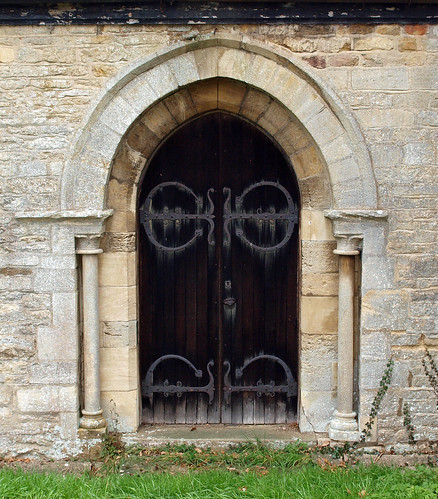ALL SAINTS. The most prominent part is the early C17 brick tower. The W window has a pediment. Of the same time also probably the low mullioned windows with uncusped lights and the porch entrance with four-centred head. The oldest feature dates from c. 1140, namely the chancel arch with big scalloped capitals, fat rolls, and abaci and bases with a flat zigzag decoration as at Castor. That the arch is pointed must be a late improvement. After that several parts of c.1190, i.e. the priest’s doorway and the N and S doorways, with waterleaf capitals and arches of one step and one chamfer. Of c.1240 is the N arcade. Three bays, round piers with base-spurs, double-chamfered arches. Of c.1260 the S arcade, similar but with a little nailhead. The bases of both arcades are of the waterholding variety. Then the SE chancel window of c.1275: two lights with plate tracery and inside an attached mid-shaft. The DOUBLE PISCINA belongs to this, with the three curious recesses in the tympanum. Can they have been for relics? The S transept S window of three lancet lights, very slightly stepped, looks late C13 too. Nothing medieval is later. - PLATE. Cup of 1728-9. - MONUMENT. Almost totally defaced effigy of a Priest, first half C 13, his feet placed against two human heads.
MORBORNE. It is set in green pastures, with an old farm and an older church. Most of the church has been here 700 years, but the chancel arch, ornamented with crosses and squares, is about a century older.
There are coffin-stones of the 13th century, some used as seats in the porch; and two old fonts, one with a 13th century bowl on a new stem, one a Norman bowl without a stem. In an arched recess is a double piscina of a kind we do not remember having seen elsewhere, 600 years old. It has two small arches with delicate carving under three odd little pigeon-holes, a startled face keeping watch over it. A curious part of the church is its crooked transept. Here is a stone priest, shown with his feet on two heads, a rather queer figure found buried under the tower. It is thought he may have been the rebuilder of the church, and we like to think that after some great adventure he has come back to a place of honour in his old church.
There are coffin-stones of the 13th century, some used as seats in the porch; and two old fonts, one with a 13th century bowl on a new stem, one a Norman bowl without a stem. In an arched recess is a double piscina of a kind we do not remember having seen elsewhere, 600 years old. It has two small arches with delicate carving under three odd little pigeon-holes, a startled face keeping watch over it. A curious part of the church is its crooked transept. Here is a stone priest, shown with his feet on two heads, a rather queer figure found buried under the tower. It is thought he may have been the rebuilder of the church, and we like to think that after some great adventure he has come back to a place of honour in his old church.



No comments:
Post a Comment